

An Introduction to Technology Integration. The 5 Steps of Effective Technology Integration - Getting Smart by Dave Guymon - edchat, EdTech, education. In schools, districts, and departments of education alike, a trend toward integrating technology into the education process is on the rise.

One could argue that it always has been. But with the proliferation of Internet access in school buildings and the ubiquity of mobile computing devices, educators are taking note and beginning to consider new ways they can include these tools into their classroom instruction. The formalized field of educational technology is still in its infancy. As a result, professional development and training practices are still being refined. NAESP. Today's students need educators to re-envision the role of technology in the classroom. by Nancye Blair Principal, January/February 2012 Web Resources A dramatic shift is sweeping through our schools.
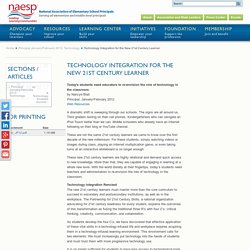
The signs are all around us. Third graders texting on their cell phones. Kindergarteners who can navigate an iPod Touch better than we can. Middle schoolers who already have an Internet following on their blog or YouTube channel. These are not the same 21st century learners we came to know over the first decade of the new millennium. These new 21st century learners are highly relational and demand quick access to new knowledge. Technology integration Remixed The new 21st century learners must master more than the core curriculum to succeed in secondary and postsecondary institutions, as well as in the workplace.
In this configuration, the teacher acts as a learning catalyst, orchestrating and facilitating activities that spark defining moments for students. This is a liberating shift. Technology In The Classroom: Tips For New Teachers To Use Technology In The Classroom. Register Now and join a community of a million educators.
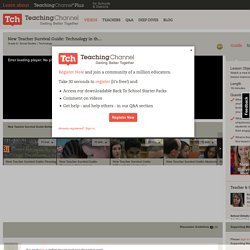
Take 30 seconds to register (it's free!) 8 Engaging Ways to use Technology in the Classroom to Create Lessons That Aren’t Boring. Are you tired of delivering the same old lectures on the same subjects year after year? Are you using the same lesson materials over and over and wishing you could make learning in your classroom more interactive? While lectures and lessons can be informative and even “edutaining” when delivered with passion and good materials by knowledgeable experts, sadly many traditional lectures and lessons are boring, and even worse often ineffective. The good news is that the Web is loaded with great free tools that can enable teachers to bring a sense of fun and engagement to their lessons.
Of course, you do need devices with Internet access to give these tools a try. Even if you don’t have computers or tablets available in your classroom, the fact that an increasing number of High School and college students have smartphones is making it easier than ever to leverage technology to create engaging, active lessons students enjoy working on. 1. 2. 3. 4. 5. 6. 7. How to Help Teachers Use Technology in the Classroom. Recent reports (from The Chronicle of Higher Education and Walden University [PDF], for example) point to teachers' continuing difficulties integrating technology into classroom learning.
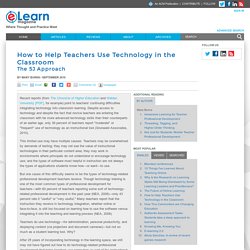
Despite access to technology and despite the fact that novice teachers are entering the classroom with far more advanced technology skills than their counterparts of an earlier age, only 39 percent of teachers report "moderate" or "frequent" use of technology as an instructional tool (Grunwald Associates, 2010). This limited use may have multiple causes: Teachers may be overwhelmed by demands of testing; they may not see the value of instructional technologies in their particular content area; they may work in environments where principals do not understand or encourage technology use; and the types of software most helpful in instruction are not always the types of applications students know how—or want—to use.
Back to the Drawing Board: The 5Js Beyond Skills Training: A Theory of Action Job-Related. Earlychildhood NEWS - Article Reading Center. We are always looking for the magic bullet, something that will solve all our problems.
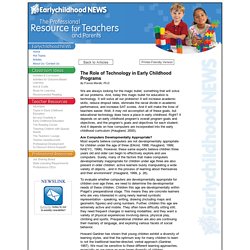
And, today this magic bullet for education is technology. It will solve all our problems! It will increase academic skills, reduce dropout rates, eliminate the racial divide in academic performance, and increase SAT scores. And it will make the lives of teachers easier. Well, it may not accomplish all of these goals, but educational technology does have a place in early childhood. Are Computers Developmentally Appropriate? To evaluate whether computers are developmentally appropriate for children over age three, we need to determine the developmental needs of these children. Howard Gardner has shown that young children exhibit a diversity of learning styles, and that the optimum way for many children to learn is not the traditional teacher-directed, verbal approach (, 1987). 1. 2. 3. 4. 5.
Technology in Education. Integrating Tech: More Than Just Having Computers. Technology has become part of the educational process, but too often it is separate and not integrated into the learning experience.Today, Education World offers easy and painless ways to integrate technology into your daily routine.
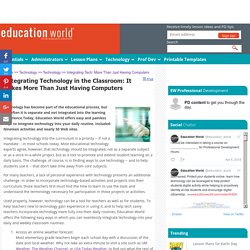
Included: Nineteen activities and nearly 50 Web sites. Integrating technology into the curriculum is a priority -- if not a mandate -- in most schools today. Most educational technology experts agree, however, that technology should be integrated, not as a separate subject or as a once-in-a-while project, but as a tool to promote and extend student learning on a daily basis. The challenge, of course, is in finding ways to use technology -- and to help students use it -- that don't take time away from core subjects.
For many teachers, a lack of personal experience with technology presents an additional challenge. Used properly, however, technology can be a tool for teachers as well as for students. Access an online weather forecast. 10 of the Most Engaging Uses of Instructional Technology (with Dozens of Resources and Tools) Are you looking for ways to integration technology in your lesson plans and courses that provide for an engaging experience for you and your students?

Fans of instructional technology know that it can be fun and inviting, and engaged students are far more likely to be learning. I believe that if you can get students involved and motivated effectively enough, you can improve their learning habits over the long term. With that in mind, here are 10 highly engaging uses of technology in the classroom, along with dozens of tools and resources for implementation. Most of these involve free web based tools, so that's an added bonus!
Interactive Collaboration The 2014 Gates Foundation report, Teachers Know Best: What Educators Want from Digital Instructional Tools, indicates that teachers want tools “supporting student collaboration and providing interactive experiences”. Gathering Feedback.